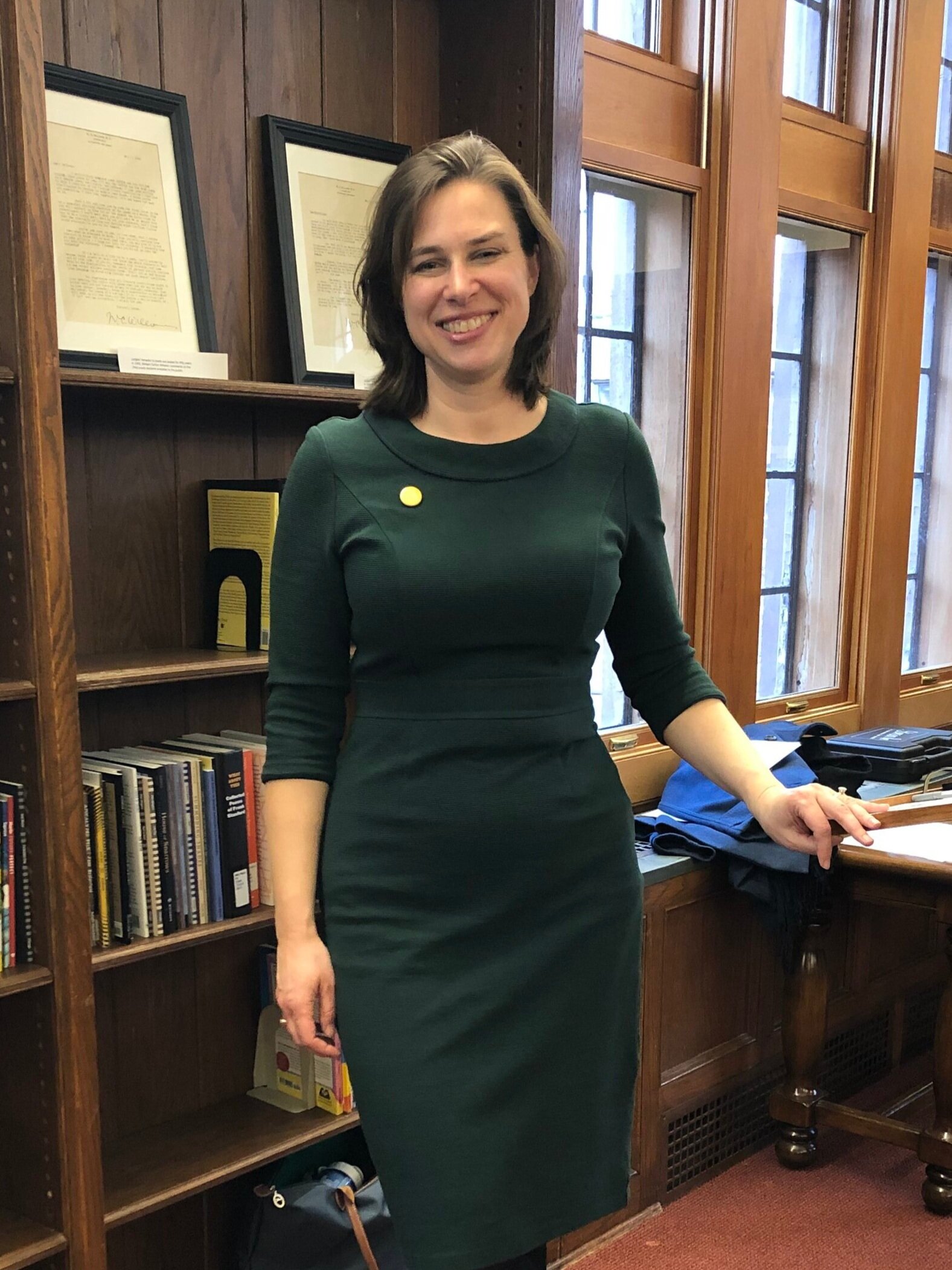Photo by Katie Goss ’23
Jensen ’99 discusses UVA’s Book Traces project, which focuses on found artifacts in previously owned library books, in the Stimson Room of the Williston Library.
BY KATIE GOSS ’23
University of Virginia (UVA) Library Project Manager Kristin Jensen ’99 gave a talk in the Stimson Room of the Williston Library on Feb. 7, titled, “Book Traces: Hidden Histories of Reading and the Future of Library Collections.”
Jensen spoke about her position as a project manager on the UVA Book Traces project, an attempt to find library collections’ books that have been somehow altered by their previous readers.
The project focuses on books published before 1923, which have been previously owned, are currently circulating in academic libraries and which have had something special left behind, such as notes, pictures and other annotations.
Also on the project is Andy Stauffer, an associate professor of English at UVA who Jensen worked with while she was in grad school. After hearing Stauffer had received a grant to do more research with Book Traces, Jensen interviewed for the project manager position.
“I really believe in what [he is] doing and I just think it’s fascinating,” Jensen said. “I was able to walk in [to this position] and say I have … worked in the UVA libraries as a grad student, I have project management experience and I’m familiar with technologies.”
The project aims to show the importance of these books as accidental artifacts, as well as the relationships historical readers had with their books. By analyzing notes, pictures, names and dates, the project is sometimes able to track down the books’ original owners. Jensen noted that this project excludes annotations made for academic purposes, as those tend to be less personal.
Jensen shared various things they found written within books, or simply placed inside, such as pictures. Usually the project finds more ordinary things, such as names or dates, but every once in a while a picture, a long note or a continuous annotation are found.
Jensen shared an old French children’s book that had been owned by a family in the early 20th century. Throughout the book are annotations, a schedule, the names “Eugenia” and “Adeline,” and even a note describing an April Fools’ Day prank, in which the girls planned to pin something onto their teachers back.
After Jensen and others involved with the Book Traces research tracked down the names of the original owners and where they had lived while owning the book, it was concluded that the owners, Eugenia and Adeline, were 12 and 14 years old at the time the book was written in. Researchers at Book Traces also discovered that their father, John Staige Davis II, had been a professor at UVA, and later became one of the first plastic surgeons to practice in America.
Other times, Book Traces finds artifacts in which the name of a book’s owner is not written, so they can only assume details about the owners’ lives. Jensen mentioned an old book of poetry as an example, where the owner modified a poem about death by adding names and dates and pluralizing singular terms. The poem then read as if multiple people had died. Since no information on the book’s owner was written in the volume, researchers at Book Traces had to guess at the annotations’ purpose.
According to Jensen, they hypothesized that the unnamed annotator must have added the names and dates of people who had died in their own life, to make the poem more relevant to them.
UVA has 12 libraries, so researchers from Book Traces were able to take samples from each library in order to complete this project. Two years in, they had taken samples from around 115,000 books and were able to judge approximately how many contained personal material.
After their survey, Jensen explained, Book Traces researchers found there were four areas that tended to be marked up most frequently: religion, philosophy, literature and history. She added that music and law books were often written in as well, but for practical — and not usually personal — reasons.
“I really like the idea of looking at old books and seeing what inscriptions have been written in there,” Maggie Geidner ’23 said. “I know I have personally written inscriptions in books before, and I always really like it when I find a book with inscriptions in it because you sort of get a peek into someone else’s mind and what they were thinking and doing when they read the book.”
“I love working with students, it’s one of my favorite parts of the job,” Jensen said. “Seeing them really getting in touch with the book as a physical object and sort of getting to lay hands on a little piece of history — I think that’s really great.”
“I hope people get out of this the appreciation of the book as a physical object and as a physical artifact,” Jensen said at the end of her talk. “I hope they understand how the book can help connect us with the past and be a piece of history, that it’s not just a container full of words, but that it’s an object that people have handled and cared for and used and loved in their life.”

